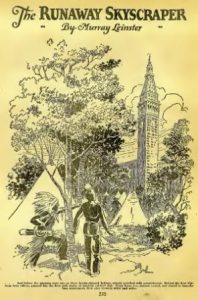 It’s time to once again return to the red book. I’m talking about that 1969 copy of The Best of Amazing, which continues to provide timeless adventures from long ago. After first appearing in the February 22, 1919 pulp classic issue of Argosy magazine, The Runaway Skyscraper by Murray Leinster is the third selection by Joseph Ross for its appearance in the June 1926, Vol. 1, No 3 issue of Amazing Stories. Not surprising, and for good reason, the story turns up yet again in the February 1966 issue of Amazing Stories.
It’s time to once again return to the red book. I’m talking about that 1969 copy of The Best of Amazing, which continues to provide timeless adventures from long ago. After first appearing in the February 22, 1919 pulp classic issue of Argosy magazine, The Runaway Skyscraper by Murray Leinster is the third selection by Joseph Ross for its appearance in the June 1926, Vol. 1, No 3 issue of Amazing Stories. Not surprising, and for good reason, the story turns up yet again in the February 1966 issue of Amazing Stories.
The story’s reappearance on the pages of Amazing Stories magazines throughout the years was no accident. Who knows, maybe someday it will grace the pages of AS once again for an entirely new generation of readers to enjoy. Until such a day, the story can still be found at Amazon and Project Gutenberg. Check it out.
The Metropolitan Tower is skyscraper located in the downtown business district of Manhattan. Arthur Chamberlain is an engineer on the cusp of losing his job if he can’t find a way to pay his investors. As he is explaining his dire situation to his stenographer Estelle Woodward, all of the clocks in the building begin to turn backwards and the sun over Manhattan starts swinging toward the east. The cycle of night and day starts flashing by faster and faster. The familiar architectural landscape of the bustling metropolis below fades with every pass of the sun until nothing but a small tribe of native Indians surrounded by a thick forest remains.
Crossing back from a fourth dimension to get to their own time does not sound as daunting as the task of trying to survive in this strange land. Along with a couple thousand occupants, Arthur and Estelle try to help the group maintain a sense of civility in this strange land.
From the start, the reader gets a real sense of the stoic social image of early twentieth-century through the timorous businessmen Arthur and the complacent subordinate Estelle. Both share a fondness for each other, but both fear the social repercussions. But over time (or would it be “under” time since they travel hundreds of years in the past), Leinster lets the reader see how social discomfort is often forced through the paradigms set by one’s society. Once they are thrown into the new (or is it old) world where self sufficiency is pivotal to survival, all social norms suddenly change. In a sense, they evolve. Suddenly Arthur assumes leadership of the skyscraper community. He sets guidelines for food and shelter and uses his keen knowledge (hey, he reads a lot of science fiction magazines so he’s definitely a bright guy) to devise a way to get back to the correct dimension. The character of Estelle develops confidence too. She becomes more assertive and relies on her mysterious past where she apparently gained experience in hunting and fishing.
The most conspicuous obstacle seemingly brushed off by the author is the inability to give up modern conveniences. Tossed into this strange land, electricity still provides power and elevators continue to ascend and descend without interruption. All of the telephones throughout the building still work. The loss of these amenities might have been too daunting to address in a short story already saturated with complexity, but the omission was just as striking.
One final observation is of the emotional tie the story reflects on our current society. The dimensional time shift the building endures is in a way, reminiscent of disasters that befall the human race around the globe even today. Face it. With such a large group, there will be compounding problems as adversity arises. But just like most instances of crisis, people eventually pull up their bootstraps and endure.

To the more extreme measure, some of the characters in this story seize the opportunity as a kind of adventure. Some even glaringly admit their pleasure with enthusiasm. I can’t help but compare it to my kids getting excited every time they discuss the notion of a zombie apocalypse. Should they really act so eager about it? Like the premise itself, their imagination sores with ideas of challenges and solutions. But their interest almost always fades away when the topic is referenced as fiction.
The Runaway Skyscraper is as monumental as its name. Author Murray Leinster might have transported a vast structure and its inhabitants through time in this ageless story of adventure and endurance, but readers get to travel back in time as well. I don’t just mean they can travel to Manhattan in the time of Indians. This amazing story keeps showing up because every generation of reader deserves the opportunity to catch a glimpse of early twentieth-century, and see Science Fiction at its best.










